Living a Behavioural Analysis
Phew.
Does anyone else feel like they aged by 10 years in the past month? If the indicators are anything to go by, it seems like we are in this for the long run. A little more aging is in store for us. As a behavioral science practitioner, I am having a fascinating out-of-body experience of watching myself exhibit all the behaviors I have always talked about in my workshops and meetings.
One of my favorite frameworks to teach and share is the BASIC toolkit [2]. Developed by the OECD to help apply behavioral science insights to public policy analysis, it draws on a taxonomy of ABCD — Attention, Belief, Choice and Determination — to help understand behavior through small-scale experimentation. As one of the most prevalent and useful behavioral frameworks for beginners and experts alike, BASIC is a mainstay of my teaching curriculum — and yet, though my meetings are for the time cancelled, I have never felt more connected to the material than I do now.
It seems a common belief these days is that we will all come out of this crisis changed. For me, perhaps the biggest change has been taking material I typically teach to others and applying it to a new subject altogether: myself.
So, let me present to you my real life, experience-based ABCD analysis of my behavior.
Behavioral Science, Democratized
We make 35,000 decisions each day, often in environments that aren’t conducive to making sound choices.
At TDL, we work with organizations in the public and private sectors—from new startups, to governments, to established players like the Gates Foundation—to debias decision-making and create better outcomes for everyone.
A for Attention
If we were as perfect as we often believe we are, we would have unlimited attention and would never forget anything. Needless to say — quite contrary to this standard of perfection — our attention is not an unlimited resource. Human attention is “scarce, easily distracted” and falls prey to several unwanted behaviors [2]. For instance, forgetting and overlooking tasks that are important (but, perhaps, unenjoyable). If I had a penny for every time I missed watering my plants in the past month, I would have enough money to employ a full-time gardener. The irony that the plants stand and plead for water right in front of me, even as I type this, is not lost on me. Maybe putting footsteps towards the plant, the way we put footsteps towards waste bins might put me on the path to keeping my plants alive.
Our limited attention span is also the main culprit for our inability to multitask. Every once in a while, you will meet people who will floor you with their multitasking skills. Don’t feel disheartened. For most of us, multitasking places us in cognitive overload, forcing us to divide our attention. Not long ago, I was one of those people who took pride in my ability to do multiple things at once. But after a month of confinement, I now know better. Cooking while trying to reply to your mail might lead to a sweet pasta or a sour note — which may or may not appeal to your taste buds. The jury is still out on that one.
As we adjust to the time at home, and the blurring of boundaries between our personal and professional lives, it helps to factor inattention into our timelines. Indeed, two of the most common mistakes we make in planning are, simultaneously, the systematic underestimation of the time it will take us to complete a task, and the overestimation of the benefits we will receive therefrom [3]. Known as the planning fallacy, it derives from both overconfidence in our abilities and inattention to details that may complicate our plans.
So, if you’re planning to cook a nice meal tonight, put aside an hour for cooking and do only that. We live in stressful times, don’t make it worse by trying to do everything at once.
B for Belief
How do we make sense of the world? How do we form our beliefs? Rational choice theory would have you believe that belief formation is a logical process: we consume, process, and evaluate information, then form a belief on that basis. But that’s not always the case, is it?
We live in a complicated world, replete with information overload [6]. Our brains do their best to process what they can, relying often on context to make sense of what’s around us. Thus, many of our beliefs will be the results of both limited processing resources and our own biased understanding of the world. And so, as expected, belief formation is not perfect. We tend to ignore relevant information that may cause dissonance; often we seek out information that confirms what we already think [9].
And as if that isn’t bad enough, emotions wreak havoc on how we consume information [8]. The quality of the emotion (i.e. negative or positive) determines how information must be consumed. Negative emotions make people seek out more negative information and vice versa [5].
I have an example for you. Sometime in February this year, I had a trip planned to Japan and I had every intention of making it to Tokyo. So, I found myself seeking out positive information about COVID 19: how many people had recovered, how many people were not affected at all. By the time I returned from Japan, the situation had deteriorated so much that my emotions had turned negative. Now, I find myself obsessively refreshing the news feed to devour the latest numbers. If you are doing that, too, don’t be too hard on yourself. Your brain is doing the best it can to process all this information while trying to manage your heart’s information needs as well.
C for Choice
Choice is a tricky one. We all feel like we are making the right choices, weighing all the necessary information and picking the right option. But behavioral science has repeatedly shown that our choices are driven by context. Whether it is the impact of framing [6], or the power of alternative options (as shown by Dan Ariely in his famous experiment on pricing for The Economist [1]), we know that choices are never made in a vacuum.
Choices are also heavily influenced by social norms. Picking a restaurant because it has a long queue is a common example of this effect. For the longest time, I thought I was immune to social norms. Even if a hotel website told me that 49 other people were looking at the same room at the same time, I could not be pressured to give in.
Now I know better. No, I did not panic-buy toilet paper. But yes, I did squirm uncomfortably reading about long lines in supermarkets the day before the lockdown began, till I gave in and went to buy a few basics, lest I’d feel left out.
D for Determination
To put it simply, we are not Mahatma Gandhi. Just like attention, our willpower is not infinite. It depletes fast due to the cognitive and physical strain we operate under. For instance, I am very determined to keep fit, so I enrolled at a gym at the beginning of the year. But by March, I already see my interest waning. By May, the gym will likely be a low priority activity. What happened to my optimism from the beginning of the year? Turns out, like many people, I am present biased [4]. My shorter-term needs of having fun outweigh the longer-term need of keeping fit. Yet even still, the events of the last month have depleted my determination more than I could have expected.
The AI Governance Challenge
This was underscored by my persistent failure to stop one behavior: touching my face. Face touching is the femme fatale of the COVID-19 crisis — yet, no matter what I read, tried, did, I could not muster the willpower and concentration to stop doing it. The more I tried, the harder it got, the more frustrated I felt. So, I turned to a trusted tool of behavioral science: the commitment device. When trying to boost your self-control doesn’t work, try increasing the hassle factor instead. I wanted to touch my face, the mask covers my face, ergo using the mask helps me not touch my face! Determination 1, Brain 0.
Self Experimentation
And so, dear readers, as you can see, I am now my own subject of experimentation — living in the frameworks I have been teaching in workshops. I am also now at peace with the fact that I am nowhere close to being a perfectly rational human being. In fact, I am beginning to enjoy my little quirks and irrationalities. Maybe, that’s what the new normal will be: people just accepting they are not perfect and cutting themselves, and each other, some slack. That’s a normal I can live with!
References
- Ariely, D. (2008). Predictably irrational. New York, NY: Harper Audio.
- Hansen, P. G. (2018). BASIC: Behavioural Insights Toolkit and Ethical Guidelines for Policy Makers.
- Kahneman, D., & Tversky, A. (1977). Intuitive prediction: Biases and corrective procedures. Decisions and Designs Inc Mclean Va.
- O’Donoghue, T., & Rabin, M. (1999). Doing it now or later. American Economic Review, 89(1), 103-124.
- Peters, E., Lipkus, I. & Diefenbach, M. A. The Functions of Affect in Health Communications and in the Construction of Health Preferences. J. Commun. 56, S140–S162 (2006).
- Sweller, J. (1994). Cognitive load theory, learning difficulty, and instructional design. Learning and instruction, 4(4), 295-312.
- Tversky, A., & Kahneman, D. (1989). Rational choice and the framing of decisions. In Multiple criteria decision making and risk analysis using microcomputers (pp. 81-126). Springer, Berlin, Heidelberg.
- Van Bavel, J. J., Boggio, P., Capraro, V., Cichocka, A., Cikara, M., Crockett, M., … & Ellemers, N. (2020). Using social and behavioral science to support COVID-19 pandemic response.
- Wason, Peter C. (1960), “On the failure to eliminate hypotheses in a conceptual task”, Quarterly Journal of Experimental Psychology, 12 (3): 129–40, ISSN 1747-0226
About the Author
Preeti Kotamarthi
Preeti Kotamarthi is the Behavioral Science Lead at Grab, the leading ride-hailing and mobile payments app in South East Asia. She has set up the behavioral practice at the company, helping product and design teams understand customer behavior and build better products. She completed her Masters in Behavioral Science from the London School of Economics and her MBA in Marketing from FMS Delhi. With more than 6 years of experience in the consumer products space, she has worked in a range of functions, from strategy and marketing to consulting for startups, including co-founding a startup in the rural space in India. Her main interest lies in popularizing behavioral design and making it a part of the product conceptualization process.





